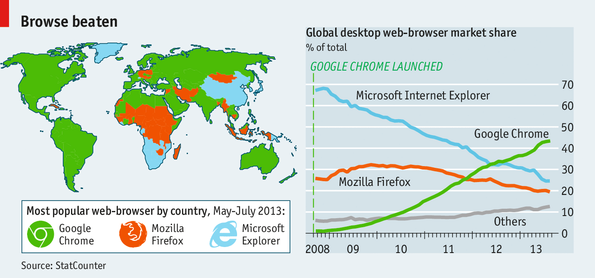As in-vehicle electronics become more sophisticated to support autonomous driving, cameras, and infotainment systems, Ethernet has become a top contender for connecting them.For example, the BMW X5 automobile, released last year, used single-pair twisted wire, 100Mbps Ethernet to connect its driver-assistance cameras.
Category: Networks
Contagious wi-fi virus created by Liverpool researchers
A computer virus that can spread via wi-fi like a “common cold” has been created by researchers in Liverpool. In densely populated areas with lots of wi-fi networks, the virus can go from network to network finding weaknesses. Once in control of a wi-fi access point, it leaves computers on the network extremely vulnerable.
via BBC News – ‘Contagious’ wi-fi virus created by Liverpool researchers.
The Economist explains: Why South Korea is really an internet dinosaur
SOUTH KOREA likes to think of itself as a world leader when it comes to the internet. It boasts the world’s swiftest average broadband speeds (of around 22 megabits per second). Last month the government announced that it will upgrade the country’s wireless network to 5G by 2020, making downloads about 1,000 times speedier than they are now. Rates of internet penetration are among the highest in the world. There is a thriving startup community (Cyworld, rolled out five years before Mark Zuckerberg launched Facebook, was the most popular social network in South Korea for a decade) and the country leads the world in video games as spectator sports. Yet in other ways the futuristic country is stuck in the dark ages. Last year Freedom House, an American NGO, ranked South Korea’s internet as only “partly free”. Reporters without Borders has placed it on a list of countries “under surveillance”, alongside Egypt, Thailand and Russia, in its report on “Enemies of the Internet”. Is forward-looking South Korea actually rather backward?
via The Economist explains: Why South Korea is really an internet dinosaur | The Economist.
Chinese Internet Traffic Redirected to Small Wyoming Building
In one of the more bizarre twists in recent Internet memory, much of the Internet traffic in China was redirected to a mysterious company in Cheyenne, Wyo., on Tuesday.A large portion of China’s 500 million Internet users were unable to load websites ending in .com, .net or .org for nearly eight hours in most regions of China, according to Compuware, a Detroit-based technology company.The China Internet Network Information Center, a state-run agency that deals with Internet affairs, said it had traced the problem to the country’s domain name system. And one of China’s biggest antivirus software vendors, Qihoo 360 Technology, said the problems affected roughly three-quarters of the country’s domain name system servers.
via Chinese Internet Traffic Redirected to Small Wyoming Building – NYTimes.com.
New approach to vertex connectivity could maximize networks’ bandwidth
Computer scientists are constantly searching for ways to squeeze ever more bandwidth from communications networks.
Now a new approach to understanding a basic concept in graph theory, known as “vertex connectivity,” could ultimately lead to communications protocols — the rules that govern how digital messages are exchanged — that coax as much bandwidth as possible from networks.
Graph theory plays a central role in mathematics and computer science, and is used to describe the relationship between different objects. Each graph consists of a number of nodes, or vertices, which represent the objects, and connecting lines between them, known as edges, which signify the relationships between them. A communications network, for example, can be represented as a graph with each node in the network being one vertex, and a connection between two nodes depicted as an edge.
via New approach to vertex connectivity could maximize networks’ bandwidth – MIT News Office.
Chrome rules the web
EMPIRES rise and fall swiftly on the internet. Google’s Chrome browser, which celebrates its fifth birthday next month, has captured much of the territory of older browsers and is now responsible for about 43% of all the web traffic generated by the world’s desktop computers. When Chrome was launched the dominant browser was Microsoft’s Internet Explorer (IE), with a 68% share—it is now down to just 25%.
Making the Web Faster with HTTP 2.0 – ACM Queue
A modern Web application looks significantly different from a decade ago. According to HTTP Archive,6 an average Web application is now composed of more than 90 resources, which are fetched from more than 15 distinct hosts, totaling more than 1,300 KB of (compressed) transferred data. As a result, a large fraction of HTTP data flows consist of small (less than 15 KB), bursty data transfers over dozens of distinct TCP connections. Therein lies the problem. TCP is optimized for long-lived connections and bulk data transfers. Network RTT (round-trip time) is the limiting factor in throughput of new TCP connections (a result of TCP congestion control), and consequently, latency is also the performance bottleneck for most Web applications.

